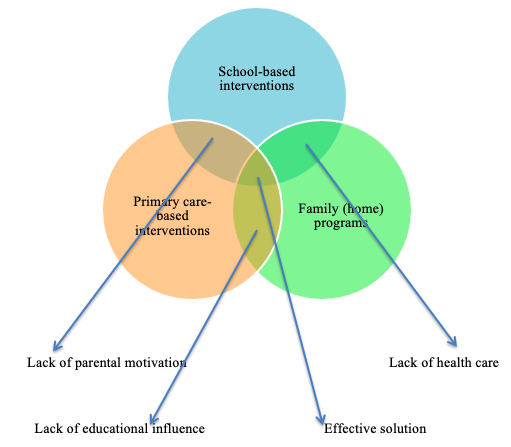Problem Solution
According to the tendency existing in the modern healthcare practice, the issue of childhood obesity is addressed with a one-sided approach. The majority of the existing programs are introduced for the elimination of some separate factors that influence obesity. They tend to target primary causes and develop a set of interventions to exclude them. Such measures prove to be insufficiently effective regarding the growing number of overweight children both in the USA and in the world.
The analysis of the available literature on the topic allows concluding that the reasons for obesity among children ground on a variety of factors, such as family and upbringing conditions, environment, lifestyle, and cultural tendencies (Sahoo et al., 2015). Thus, there is an urgent need to utilize a multifaceted approach, which would enable effective problem resolution utilizing a complex of related measures. These measures should incorporate school-based interventions, primary care-based interventions, and home programs. It is essential to raise awareness about the consequences obesity has on children’s health.
That is why, within the introduced strategy, special programs for schools, primary care units, and families will be developed. They will work in a system for educational and preventive purposes. While the effectiveness of the program implementation in schools and medical institutions seems to present a minimal challenge, the implementation of the strategy at the family level proves to be more complicated. According to the study conducted by Rhee, Kessl, Lindback, Littman, and El-Kareh (2018), “lack of parent motivation and readiness to address obesity” was one of the main barriers preventing the successful implementation of the interventions (p. 4).
Thus, even in the case of effective application of the program at the school and primary care levels, a poor contribution from the parents’ side would damage the overall result. The interventions will embrace more than physical culture and exercises or pediatric check-ups (Ten Hoor, Plasqui, Schols, & Kok, 2017; Rhee et al., 2018). The introduced solution program aims to incorporate the aspects of physical activity, obesity-related health issues awareness, and psychological readiness, which will be promoted in schools, in medical institutions, and in families.
Benefits
All of the interventions should combine a positively directed approach introduced by Ten Hoor et al. (2017) with the explicit explanation of the adverse outcomes of excess weight on children’s health and their longevity in adulthood. The introduced solution to the problem of childhood obesity presents efficiency benefits due to the multifaceted approach it utilizes. Other programs tend to combine only one or two directions of influence and fail to deliver the final result of obesity rates minimization. The current system of measures unifies three main spheres of influence to address all the possible ways to eliminate obesity as a health threat for children.

The chart shows the interconnection between the various components of the obesity solution programs and their influence on the overall result. Firstly, the combination of school-based interventions with primary care-based interventions excluding home programs cannot be effective due to the lack of parental motivation. Secondly, the combination of primary care-based interventions and family programs does not allow educational influence. Thirdly, when school-based interventions are combined with family programs only, the health care is excluded, which diminishes the effectiveness of the interventions. However, the collaboration of all three components enables an effective solution to the issue.
Conclusion
In conclusion, the currently introduced project addresses the childhood obesity problem and discovers the inconsistency between the existing programs and their implementation in real life. In a situation when the utilization of one-sided approaches fails to deliver a noticeable reduction of childhood obesity rates, a multifaceted approach is urgently needed.
Interdisciplinary addressing of the issues is capable of empowering the scope of influential parties and contributing to the overall result, which is comprised of the minimization of the number of overweight children. Thus, the program has to reach a shared inclusion of every party (schools, primary care units, and parents) interested in the positive solution to the problem of obesity among children.
The introduced solution embraces a system of interdependent interventions within three main domains: schools, primary care institutions, and families. It is asserted that a combination of any of the two components would fail to deliver the estimated outcomes. Only a complex program incorporating the interventions within each of the three facets will be sufficiently effective in minimization of an overweight tendency among children.
The unified efforts of educators, medical workers, and, most importantly, parents will enable the achievement of positive results. Applying the necessary measures at every level of influence is vital. In comparison with other solutions employed to the problem of obese children, the current program introduces a complex of specific measures. Such a program aims to raise awareness about the adverse effects of excess weight on health and longevity, prevent childhood obesity, and, ultimately, reduce the rates of obese children in the USA.
References
Rhee, K. E., Kessl, S., Lindback, S., Littman, M., & El-Kareh, R. E. (2018). Provider views on childhood obesity management in primary care settings: A mixed methods analysis. BMC Health Services Research. 18(1). Web.
Sahoo, K., Sahoo, B., Choudhury, A. K., Sofi, N. Y., Kumar, R., & Bhadoria, A. S. (2015). Childhood obesity: Causes and consequences. Journal of Family Medicine and Primary Care, 4(2), 187-192.
Ten Hoor, G. A., Plasqui, G., Schols, A. M. W. J., & Kok, G. (2017). Development, implementation, and evaluation of an interdisciplinary theory- and evidence-based intervention to prevent childhood obesity: Theoretical and methodological lessons learned. Frontiers in Public Health, 5. Web.
